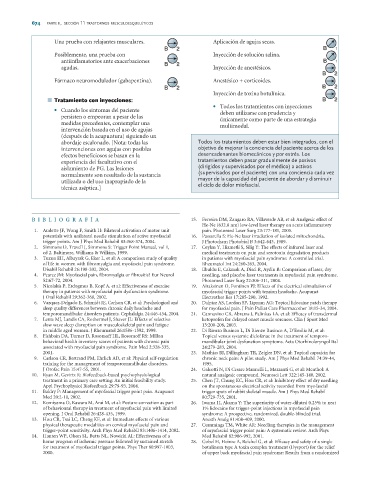Page 661 - medicina-integrativa_compress
P. 661
674 PARTE II, SECCIÓN 11 TRASTORNOS MUSCULOESQUELÉTICOS
Una prueba con relajantes musculares. Aplicación de agujas secas.
B B 2 2 B B 1
Posiblemente, una prueba con Inyección de solución salina.
antiinflamatorios ante exacerbaciones B B 2 2 B B 1
agudas. Inyección de anestésicos.
B B 2 2
Fármaco neuromodulador (gabapentina). Anestésico + corticoides.
B B 2 2 B B 2 2
Inyección de toxina botulínica.
■ Tratamiento con inyecciones: B B 2 2
• Todos los tratamientos con inyecciones
• Cuando los síntomas del paciente
deben utilizarse con prudencia y
persisten o empeoran a pesar de las únicamente como parte de una estrategia
medidas precedentes, contemplar una multimodal.
intervención basada en el uso de agujas
(después de la acupuntura) siguiendo un
abordaje escalonado. [Nota: todas las Todos los tratamientos deben estar bien integrados, con el
intervenciones con agujas con posibles objetivo de mejorar la conciencia del paciente acerca de los
efectos beneficiosos se basan en la desencadenantes biomecánicos y por estrés. Los
experiencia del facultativo con el tratamientos deben pasar gradualmente de pasivos
aislamiento de PG. Las lesiones (dirigidos y supervisados por el médico) a activos
normalmente son resultado de la sustancia (supervisados por el paciente) con una conciencia cada vez
utilizada o del uso inapropiado de la mayor de la capacidad del paciente de abordar y disminuir
el ciclo de dolor miofascial.
técnica aséptica.]
BIBLIOGRAFÍA 15. Ferreira DM, Zangaro RA, Villaverde AB, et al: Analgesic effect of
He-Ne (632.8 nm) low-level laser therapy on acute inflammatory
1. Audette JF, Wang F, Smith H: Bilateral activation of motor unit pain. Photomed Laser Surg 23:177-181, 2005.
potentials with unilateral needle stimulation of active myofascial 16. Passarella S: He-Ne laser irradiation of isolated mitochondria.
trigger points. Am J Phys Med Rehabil 83:368-374, 2004. J Photochem Photobiol B 3:642-643, 1989.
2. Simmons D, Travell J, Simmons S: Trigger Point Manual, vol 1, 17. Ceylan Y, Hizmetli S, Silig Y: The effects of infrared laser and
ed 2. Baltimore, Williams & Wilkins, 1999. medical treatments on pain and serotonin degradation products
3. Tuzun EH, Albayrak G, Eker L, et al: A comparison study of quality in patients with myofascial pain syndrome: A controlled trial.
of life in women with fibromyalgia and myofascial pain syndrome. Rheumatol Int 24:260-263, 2004.
Disabil Rehabil 26:198-202, 2004. 18. Ilbuldu E, Cakmak A, Disci R, Aydin R: Comparison of laser, dry
4. Pearce JM: Myofascial pain, fibromyalgia or fibrositis? Eur Neurol needling, and placebo laser treatments in myofascial pain syndrome.
52:67-72, 2004. Photomed Laser Surg 22:306-311, 2004.
5. Nicolakis P, Erdogmus B, Kopf A, et al: Effectiveness of exercise 19. Airaksinen O, Pontinen PJ: Effects of the electrical stimulation of
therapy in patients with myofascial pain dysfunction syndrome. myofascial trigger points with tension headache. Acupunct
J Oral Rehabil 29:362-368, 2002. Electrother Res 17:285-290, 1992.
6. Vazquez-Delgado E, Schmidt JE, Carlson CR, et al: Psychological and 20. Dalpiaz AS, Lordon SP, Lipman AG: Topical lidocaine patch therapy
sleep quality differences between chronic daily headache and for myofascial pain. J Pain Palliat Care Pharmacother 18:15-34, 2004.
temporomandibular disorders patients. Cephalalgia 24:446-454, 2004. 21. Cannavino CR, Abrams J, Palinkas LA, et al: Efficacy of transdermal
7. Lentz MJ, Landis CA, Rothermel J, Shaver JL: Effects of selective ketoprofen for delayed onset muscle soreness. Clin J Sport Med
slow wave sleep disruption on musculoskeletal pain and fatigue 13:200-208, 2003.
in middle aged women. J Rheumatol 26:1586-1592, 1999. 22. Di Rienzo Businco L, Di Rienzo Businco A, D’Emilia M, et al:
8. Fishbain DA, Turner D, Rosomoff HL, Rosomoff RS: Millon Topical versus systemic diclofenac in the treatment of temporo-
behavioral health inventory scores of patients with chronic pain mandibular joint dysfunction symptoms. Acta Otorhinolaryngol Ital
associated with myofascial pain syndrome. Pain Med 2:328-335, 24:279-283, 2004.
2001. 23. Mathias BJ, Dillingham TR, Zeigler DN, et al: Topical capsaicin for
9. Carlson CR, Bertrand PM, Ehrlich AD, et al: Physical self-regulation chronic neck pain: A pilot study. Am J Phys Med Rehabil 74:39-44,
training for the management of temporomandibular disorders. 1995.
J Orofac Pain 15:47-55, 2001. 24. Galeotti N, Di Cesare Mannelli L, Mazzanti G, et al: Menthol: A
10. Ryan M, Gevirtz R: Biofeedback-based psychophysiological natural analgesic compound. Neurosci Lett 322:145-148, 2002.
treatment in a primary care setting: An initial feasibility study. 25. Chen JT, Chung KC, Hou CR, et al: Inhibitory effect of dry needling
Appl Psychophysiol Biofeedback 29:79-93, 2004. on the spontaneous electrical activity recorded from myofascial
11. Baldry P: Management of myofascial trigger point pain. Acupunct trigger spots of rabbit skeletal muscle. Am J Phys Med Rehabil
Med 20:2-10, 2002. 80:729-735, 2001.
12. Komiyama O, Kawara M, Arai M, et al: Posture correction as part 26. Iwama H, Akama Y: The superiority of water-diluted 0.25% to neat
of behavioural therapy in treatment of myofascial pain with limited 1% lidocaine for trigger-point injections in myofascial pain
opening. J Oral Rehabil 26:428-435, 1999. syndrome: A prospective, randomized, double-blinded trial.
13. Hou CR, Tsai LC, Cheng KF, et al: Immediate effects of various Anesth Analg 91:408-409, 2000.
physical therapeutic modalities on cervical myofascial pain and 27. Cummings TM, White AR: Needling therapies in the management
trigger-point sensitivity. Arch Phys Med Rehabil 83:1406-1414, 2002. of myofascial trigger point pain: A systematic review. Arch Phys
14. Hanten WP, Olson SL, Butts NL, Nowicki AL: Effectiveness of a Med Rehabil 82:986-992, 2001.
home program of ischemic pressure followed by sustained stretch 28. Gobel H, Heinze A, Reichel G, et al: Efficacy and safety of a single
for treatment of myofascial trigger points. Phys Ther 80:997-1003, botulinum type A toxin complex treatment (Dysport) for the relief
2000. of upper back myofascial pain syndrome: Results from a randomized

